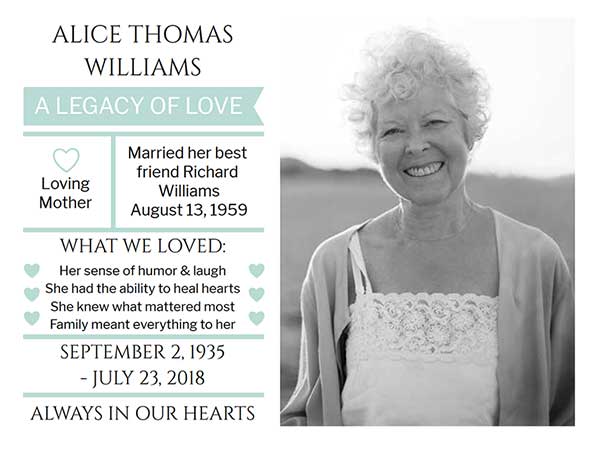The death of a relative or friend starts a period of great difficulty for everyone involved. In addition to feelings of grief, those closest to the deceased must deal with logistical aspects of the tragedy, including notifications about the funeral, memorial and other gatherings that need to get distributed.
To simplify this burden, we’ve created a set of recommendations for wording death announcements and how to organize the process. We hope our guidance serves to make a difficult time go just a little smoother.
The Basics of Heartfelt Death Announcement Wording
A death announcement notifies the community that someone has passed. Because it is almost impossible to know everyone connected to the deceased, it is essential to disseminate the death announcement as widely as possible. That means a paid obituary in a newspaper, but even that is limited in terms of coverage. For this reason, we also recommend an online notification which can be easily sent to a large number of people including your own friends and family, as well as those of the dear departed, if you have access to their contact records. If the deceased had a Facebook account, that is also a means to distribute the death announcement.
A death announcement is typically brief, particularly any that are printed in newspapers (which often charge per word or letter). As a starting point for how to write a death announcement, basic information to be included should cover full name (including maiden name), dates of birth and death, and location of death. If you have more space, you may add cause of death, “survived by” (i.e. names of close, living family members), and details regarding the funeral and/or memorial service. If the service is public, provide the date, time, and location.
Expanded Death Announcement Wording & Messaging
In case you would like to go beyond the basics, there are a number of subjects to which you can refer in the death announcement. Elements to consider include:
- Name of the organization or charity for mourners to send donations
- Basics of the deceased’s education (names of schools, degrees)
- Military service, including unit, rank, combat experience, and awards
- Employment history such as names of firms and professional positions
- Memberships in religious, civic, and cultural organizations
Death Announcement Email Subject Line
A subject line is brief yet sensitive, so you definitely want to put a little bit of thought into it. You might consider one of the following:
- The Smith Family announces the loss of John Smith
- We regret to inform you of the passing of Jane Smith
- We mourn the passing of John Smith
Managing the Writing of a Death Announcement
It is best not to put the whole responsibility of writing a death announcement on one person. Even if you were close to the deceased, other family members might have some important information to provide, or be particularly sensitive to an aspect of the death announcement. Therefore, try to work within a group and consult with all the central family members. This will save time and reduce miscommunication about a very delicate issue.
Start the task by agreeing on the outline of the death notice, and then fill in the details. Make sure that no faux-pas end up on the final copy (for example, mention of an estranged family member or regrettable business association). Finally, have a couple of participants proofread the final copy in order to avoid typos and similar errors.
Examples of Death Announcement Wording
There are many variations of death announcement wording, but most types fall into two categories: formal and personal. Because the announcement will reach people that you might not know, it is prudent to stick with traditional phrasing, such as:
- It is with our deepest sorrow that we inform you of the death of our beloved husband and father (insert name).
- With great sadness, we announce the loss of our beloved father, (insert name).
- In loving memory of (insert name), we are saddened to announce their passing on (insert date).
- A life so beautifully lived deserves to be beautifully remembered. Please join us to mourn the passing of (insert name).
- (Insert name) passed away on (insert date) at (insert place).
Follow the phrase of your choice with the information listed in the above paragraphs.
 Workplace Death Announcements
Workplace Death Announcements
In the event of a workplace death, it often falls to the direct manager of the deceased employee to make the death announcement. In addition to the basic data detailed above, it might also be of interest to mention how long the employee was at the firm and in what capacity, while giving a bit more professional information than a standard death notice. Don’t forget to mention if and how the family prefers that any donations or condolence letters should be delivered.
How We Can Help
Smilebox supports its clients during troubled times with a number of messaging media. Before or after the funeral, and even on the anniversary of their passing, consider using our slideshow maker to create a memorial slideshow that commemorates the life of a loved one. We also invite you to take a look at our sympathy card maker that can be used to send a thoughtful note to the family.








